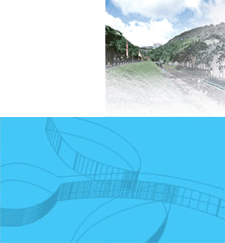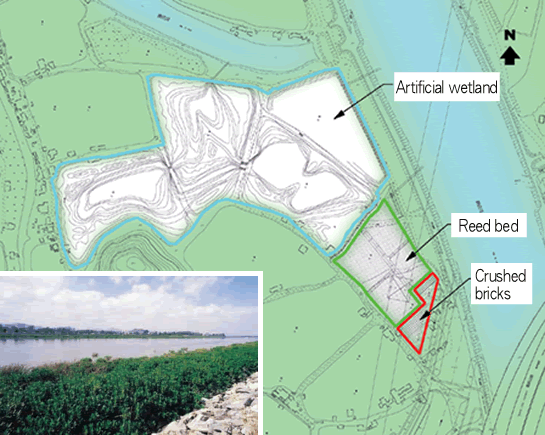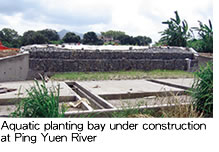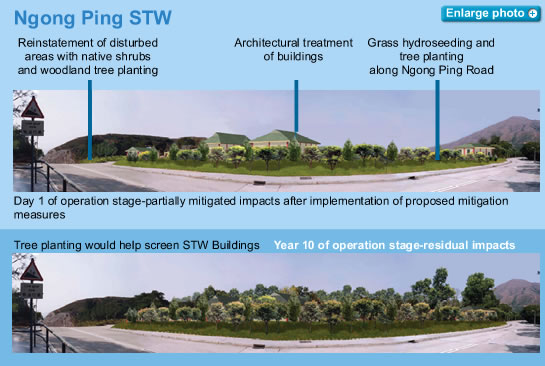
A Green Focus
The Environment is Hong Kong's important asset. DSD is fully committed
to integrating environmental protection and sustainable development
principles into our plans and operations. Three of our new projects
- the Yuen Long Bypass Floodway, Rehabilitation of Ping Yuen River
and Ngong Ping Sewage Treatment Works, illustrate our endeavours in
fulfilling these goals. These projects place particular emphasis on
enhancing biodiversity and integration of the works into the surrounding
environment.
Yuen Long Bypass Floodway
The Yuen Long Bypass floodway is a new channel constructed to divert
storm water from south east of Yuen Long into Kam Tin River to reduce
flood risk in Yuen Long town centre and other lower lying areas. In
recognizing the value of biologically diverse community at the lower
reach of Kam Tin River, this flood prevention project will incorporate
two major ecological features - an artificial wetland and in-channel
shallow ponds. |
Artificial Wetland
Several fallow fish ponds in the north of the confluence of the Bypass
Floodway and Kam Tin River will be enriched to become 7.9 ha of wetland,
comprising 6.4 ha of marshes of varying depths, 1.2 ha of reedbed
and 0.3 ha of crushed bricks.

Differential depths sustain a diversity of ecological niches. The
deeper marsh provides habitat for large fishes and the associated
bird community, while the shallower submerged marsh will be ideal
as foraging grounds for wading birds. Planting of marsh vegetation
will jump start the plant establishment process which will lead to
colonisation of the wetland by insects, aquatic invertebrates, fishes,
amphibians, reptiles and birds. The biodiversity of the created wetland
will thus be a quantum leap from that of the original fishponds.
The reed bed will receive the flow from the channel through an area
of crushed bricks that acts as a biofilter to break down organic matter.
The reed bed further serves as an effective purifier which assimilates
nutrients. Passage of flow over the boulder area and the reed bed
therefore gives a steady supply of clean water to the marshes.
Two bat roosts will also be constructed in the wetland to encourage
habitation of this type of flying mammal.
Ecologically important animal life attracted to the YLBF wetland will
include damselflies, spotted narrow-mouth frog (Kalophrynus pleurostigma),
bats such as Japanese Pipistrelle, birds both resident and visitors
such as egrets, pond heron, Stints, and the endangered Black-faced
Spoonbill.
Shallow pond feature
To promote and sustain stream life, 350 m length of channel bed or
about 1.2 ha of the floodway will take the form of shallow ponds that
are purposely engineered to provide habitat for freshwater fish, amphibians
and water birds. It is the first of its kind in Hong Kong, of a man-made
waterway that serves a flood prevention purpose while specially built
to become a vibrant freshwater ecosystem.
 |
Landscaping
Landscape quality of YLBF is enhanced with establishment of
grass on the channel base and the inner embankment on grassing
concrete, giving a total of 6.8ha of greenery. About 3,000 trees
will be planted along the channel to compensate for the loss
of 400 trees. Grass cover and trees have tremendous environmental
benefits as they reduce heat retention, provide foliage, shades
and landscape features to the water edge, trap dustfall and
increase habitat diversity and amenity value.
|
Success of this project will go a long way in providing valuable reference
for future channel engineering work to c o e x i s t w i t h n a t
u r e conservation.
The Rehabilitation Works at Ping Yuen River
This project includes the construction of about 1.7km long trapezoidal
drainage channel aiming at alleviating the flooding problem in the
Northern NT, including Chow Tin Tsuen, Lei Uk, Fung Wong Wu, Lin Ma
Hang Road and Ping Che Road in Ta Kwu Ling.
Realising the remoteness of this area which has nourished a number
of native species of freshwater fishes and bats, DSD has incorporated
nature conservation features in the design of this flood prevention
works. These include:
| (a) |
Enrichment of new channel banks with landscape
planting preferably with native species of trees and shrubs |
| (b) |
Preservation of several meanders to allow
some sections of riparian and stream habitats to remain
totally undisturbed. |
| (c) |
Creation of a number of shallow pools as
aquatic planting bays at channel base of the new river
channels; and |
| (d) |
Use of fabric geotextile-reinforced grass
lining at side slopes to provide a permeable substrate
that would allow ecological succession of plant communities. |
|
Harmonising new works with the surrounding
The Ngong Ping Sewage Treatment Works serves the Po Lin Monastery,
Ngong Ping Village, and the future theme village associated with the
Tung Chung Cable Car ride. Construction is already underway. The landscape
and social setting had been studied in detail to path way for a meticulously
designed architecture that blends seamlessly into the local area.
In particular, most of the major structures of the sewage treatment
works will be underground or covered. Generous planting of native
woodland trees and shrubs is specified in the landscape plan to compensate
for loss of any existing vegetation, to screen sensitive views and
to act as an environmental benefit for local residents, workers, and
visitors.
Furthermore, the choice of architectural design and finishing of the
superstructures will adopt traditional Chinese elements and colours
interpreted in a contemporary manner to make the sewage treatment
plant inconspicuous and fit smoothly into the landscape character
of the area.

The Ngong Ping STW will also be Hong Kong's first tertiary treatment
plant that includes ultra fine screening and effluent disinfection
by ultraviolet light. Effluent will be reused as far as practicable.
Surplus will be transported away by pipeline to Tai O Creek to avoid
undermining the fragile ecology of the Ngong Ping highland area.

|
|


